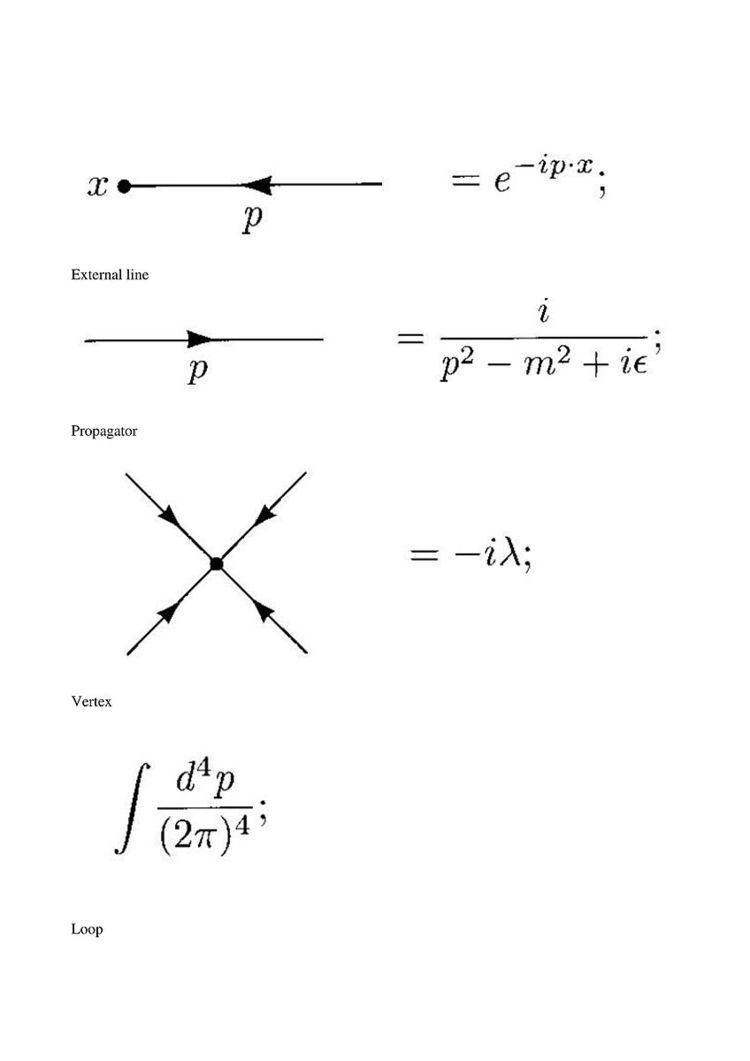 | ||
This article refers to a type of self-interaction in scalar field theory, a topic in quantum field theory. Other types of quartic interactions may be found under the topic of four-fermion interactions. A classical free scalar field
Contents
- The Lagrangian
- Feynman integral quantization
- Renormalization
- Spontaneous symmetry breaking
- Spontaneous breaking of discrete symmetries
- Exact solutions
- References
This article uses the (+−−−) metric signature for Minkowski space.
The Lagrangian
The Lagrangian for a real scalar field with a quartic interaction is
This Lagrangian has a global Z2 symmetry mapping
For two scalar fields
which can be written more concisely introducing a complex scalar field
Expressed in terms of this scalar field, the above Lagrangian becomes
which is thus equivalent to the SO(2) model of real scalar fields
With
Expanding the complex field in real and imaginary parts shows that it is equivalent to the SO(2) model of real scalar fields.
In all of the models above, the coupling constant
Feynman integral quantization
The Feynman diagram expansion may be obtained also from the Feynman path integral formulation. The time ordered vacuum expectation values of polynomials in φ, known as the n-particle Green's functions, are constructed by integrating over all possible fields, normalized by the vacuum expectation value with no external fields,
All of these Green's functions may be obtained by expanding the exponential in J(x)φ(x) in the generating function
A Wick rotation may be applied to make time imaginary. Changing the signature to (++++) then gives a φ4 statistical mechanics integral over a 4-dimensional Euclidean space,
Normally, this is applied to the scattering of particles with fixed momenta, in which case, a Fourier transform is useful, giving instead
where
The standard trick to evaluate this functional integral is to write it as a product of exponential factors, schematically,
The second two exponential factors can be expanded as power series, and the combinatorics of this expansion can be represented graphically. The integral with λ = 0 can be treated as a product of infinitely many elementary Gaussian integrals, and the result may be expressed as a sum of Feynman diagrams, calculated using the following Feynman rules:
The last rule takes into account the effect of dividing by
Renormalization
The integrals over unconstrained momenta, called "loop integrals", in the Feynman graphs typically diverge. This is normally handled by renormalization, which is a procedure of adding divergent counter-terms to the Lagrangian in such a way that the diagrams constructed from the original Lagrangian and counterterms are finite. A renormalization scale must be introduced in the process, and the coupling constant and mass become dependent upon it. It is this dependence that leads to the Landau pole mentioned earlier, and requires that the cutoff be kept finite. Alternatively, if the cutoff is allowed to go to infinity, the Landau pole can be avoided only if the renormalized coupling runs to zero, rendering the theory trivial.
Spontaneous symmetry breaking
An interesting feature can occur if m2 happens to be negative, but with λ positive. In this case, the vacuum consists of two lowest-energy states, each of which spontaneously breaks the Z2 global symmetry of the original theory. This leads to the appearance of interesting collective states like domain walls. In the O(2) theory, the vacua would lie on a circle, and the choice of one would spontaneously break the O(2) theory. A continuous broken symmetry leads to a Goldstone boson. This type of spontaneous symmetry breaking is the essential component of the Higgs mechanism.
Spontaneous breaking of discrete symmetries
The simplest relativistic system in which we can see spontaneous symmetry breaking is one with a single scalar field
where
Minimizing the potential with respect to
We now expand the field around this minimum writing
and substituting in the lagrangian we get
where we notice that the scalar
Thinking in terms of vacuum expectation values lets us understand what happens to a symmetry when it is spontaneously broken. The original Lagrangian was invariant under the
are both minima, there must be two different vacua:
Since the
Exact solutions
There exists a set of exact classical solutions to the equation of motion of the theory written in the form
that can be written for the massless,
with
The interesting point is that we started with a massless equation but the exact solution describes a wave with a dispersion relation proper to a massive solution. When the mass term is not zero one gets
being now the dispersion relation
Finally, for the case of a symmetry breaking one has
being
These wave solutions are interesting as, notwithstanding we started with an equation with a wrong mass sign, the dispersion relation has the right one. Besides, Jacobi function
A proof of uniqueness can be provided if we note that the solution can be sought in the form
